
The Space Shuttle program was the fourth human spaceflight program carried out by the U.S. National Aeronautics and Space Administration (NASA), which accomplished routine transportation for Earth-to-orbit crew and cargo from 1981 to 2011. Its official name, Space Transportation System (STS), was taken from a 1969 plan for a system of reusable spacecraft of which it was the only item funded for development. It flew 135 missions and carried 355 astronauts from 16 countries, many on multiple trips.

Sally Kristen Ride was an American astronaut and physicist. Born in Los Angeles, she joined NASA in 1978, and in 1983 became the first American woman and the third woman to fly in space, after cosmonauts Valentina Tereshkova in 1963 and Svetlana Savitskaya in 1982. She was the youngest American astronaut to have flown in space, having done so at the age of 32.

Michael John Smith, was an American engineer and astronaut. He served as the pilot of the Space Shuttle Challenger when it was destroyed during the STS-51-L mission, when it broke up 73 seconds into the flight, and at an altitude of 48,000 feet (14.6 km), killing all 7 crew members. Smith's voice was the last one heard on the Challenger voice recorder.
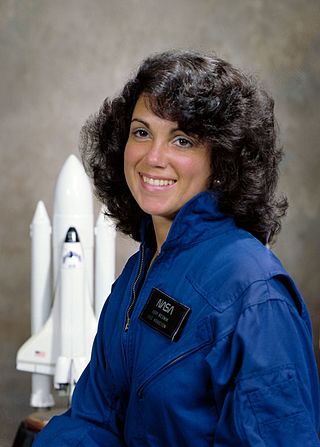
Judith Arlene Resnik was an American electrical engineer, software engineer, biomedical engineer, pilot and NASA astronaut who died in the Space Shuttle Challenger disaster. She was the fourth woman, the second American woman and the first Jewish woman of any nationality to fly in space, logging 145 hours in orbit.

Andrew "Andy" Sydney Withiel Thomas, AO is an Australian and American aerospace engineer and a former NASA astronaut. He has dual nationality; he became a U.S. citizen in December 1986, hoping to gain entry to NASA's astronaut program. He is married to fellow NASA astronaut Shannon Walker.

The Teacher in Space Project (TISP) was a NASA program announced by Ronald Reagan in 1984 designed to inspire students, honor teachers, and spur interest in mathematics, science, and space exploration. The project would carry teachers into space as Payload Specialists, who would return to their classrooms to share the experience with their students.

STS-27 was the 27th NASA Space Shuttle mission, and the third flight of Space Shuttle Atlantis. Launching on December 2, 1988, on a four-day mission, it was the second shuttle flight after the Space Shuttle Challenger disaster of January 1986. STS-27 carried a classified payload for the U.S. Department of Defense (DoD), ultimately determined to be a Lacrosse surveillance satellite. The vessel's heat shielding was substantially damaged during lift-off, and crew members thought that they would die during reentry. This was a situation that was similar to the one that would prove fatal 15 years later on STS-107. Compared to the damage that Columbia sustained on STS-107, Atlantis experienced more extensive damage. However, this was over less critical areas and the missing tile was over an antenna which gave extra protection to the spacecraft structure. The mission landed successfully, although intense heat damage needed to be repaired.

Richard Michael Mullane is an engineer and weapon systems officer, a retired USAF officer, and a former NASA astronaut. During his career, he flew as a mission specialist on STS-41-D, STS-27, and STS-36.
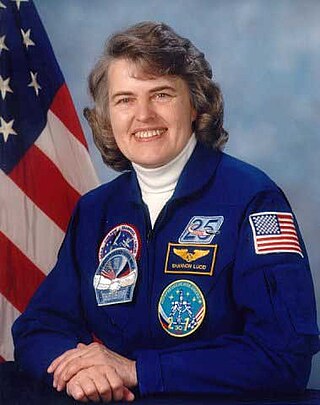
Shannon Matilda Wells Lucid is an American biochemist and retired NASA astronaut. She has flown in space five times, including a prolonged mission aboard the Russian space station Mir in 1996, and is the only American woman to have stayed on Mir. From 1996 to 2007, Lucid held the record for the longest duration spent in space by an American and by a woman. She was awarded the Congressional Space Medal of Honor in December 1996, making her the tenth person and the first woman to be accorded the honor.

Margaret Rhea Seddon is an American surgeon and retired NASA astronaut. After being selected as part of the first group of astronauts to include women in 1978, she flew on three Space Shuttle flights: as a mission specialist on STS-51-D and STS-40, and as a payload commander for STS-58, accumulating over 722 hours in space. On these flights, she built repair tools for a US Navy satellite and performed medical experiments.

The United States Astronaut Badge is a badge of the United States, awarded to military and civilian personnel who have completed training and performed a successful spaceflight. A variation of the astronaut badge is also issued to civilians who are employed with the National Aeronautics and Space Administration as specialists on spaceflight missions. It is the least-awarded qualification badge of the United States military.

Homer Hadley Hickam Jr. is an American author, Vietnam War veteran, and a former NASA engineer who trained the first Japanese astronauts. His 1998 memoir Rocket Boys was a New York Times Best Seller and was the basis for the 1999 film October Sky. Hickam's body of written work also includes several additional best-selling memoirs and novels, including the "Josh Thurlow" historical fiction novels, his 2015 best-selling Carrying Albert Home: The Somewhat True Story of a Man, his Wife, and her Alligator and in 2021 the sequel to Rocket Boys titled Don't Blow Yourself Up: The Further Adventures and Travails of the Rocket Boy of October Sky. His books have been translated into many languages.

STS-51-L was the 25th mission of the NASA Space Shuttle program and the final flight of Space Shuttle Challenger.

A payload specialist (PS) was an individual selected and trained by commercial or research organizations for flights of a specific payload on a NASA Space Shuttle mission. People assigned as payload specialists included individuals selected by the research community, a company or consortium flying a commercial payload aboard the spacecraft, and non-NASA astronauts designated by international partners. Following the destruction of Columbia in 2003, no more payload specialists ever flew.
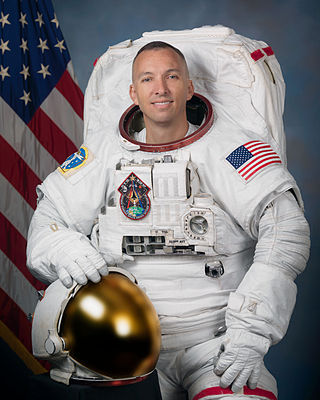
Randolph James "Komrade" Bresnik is a retired officer in the United States Marine Corps and an active NASA astronaut. A Marine Aviator by trade, Bresnik was selected as a member of NASA Astronaut Group 19 in May 2004. He first launched to space on STS-129, then served as flight engineer for Expedition 52, and as ISS commander for Expedition 53.
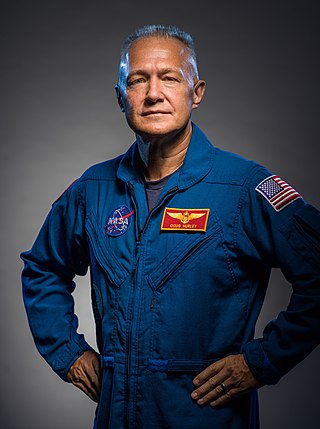
Douglas Gerald Hurley is an American engineer, former Marine Corps pilot and former NASA astronaut. He piloted Space Shuttle missions STS-127 and STS-135, the final flight of the Space Shuttle program. He launched into space for the third time as commander of Crew Dragon Demo-2, the first crewed spaceflight from American soil since STS-135 and became, together with Bob Behnken, the first astronaut in history launching aboard a commercial orbital spacecraft. He was also the first Marine to fly the F/A-18 E/F Super Hornet. His call sign is "Chunky", and he was sometimes referred to by this name on the communication loops.
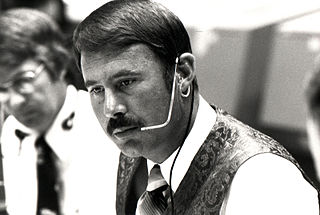
Donald Ray Puddy was a NASA engineer and manager. He joined NASA in 1964, eventually becoming the agency's tenth flight director. His Flight Team colors were Crimson. He served as a flight director during the Apollo 17, Skylab, and Apollo-Soyuz Test Project missions, Skylab, and the first Space Shuttle mission. He earned a number of awards for his service, including the Presidential Medal of Freedom and the NASA Outstanding Leadership Medal.
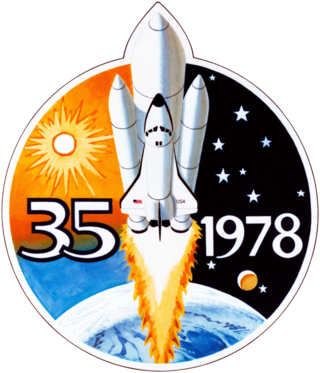
NASA Astronaut Group 8 was a group of 35 astronauts announced on January 16, 1978. It was the first NASA selection since Group 6 in 1967, and was the largest group to that date. The class was the first to include female and minority astronauts; of the 35 selected, six were women, one of them being Jewish American, three were African American, and one was Asian American. Due to the long delay between the last Apollo lunar mission in 1972 and the first flight of the Space Shuttle in 1981, few astronauts from the older groups remained, and they were outnumbered by the newcomers, who became known as the Thirty-Five New Guys (TFNG). Since then, a new group of candidates has been selected roughly every two years.

Mission: Earth, Voyage to the Home Planet is a children's literature book by science writer June A. English and astronaut Thomas David Jones that was published in 1996 by Scholastic. Jones was among the crew members of the Space Shuttle Endeavour during an eleven-day mission in space, which was launched in April 1994 to study the ecological well-being of Earth using specialized radar technology. The book, which is illustrated with radar images and picturesque photographs, chronicles the mission and Jones' experiences of it.



















